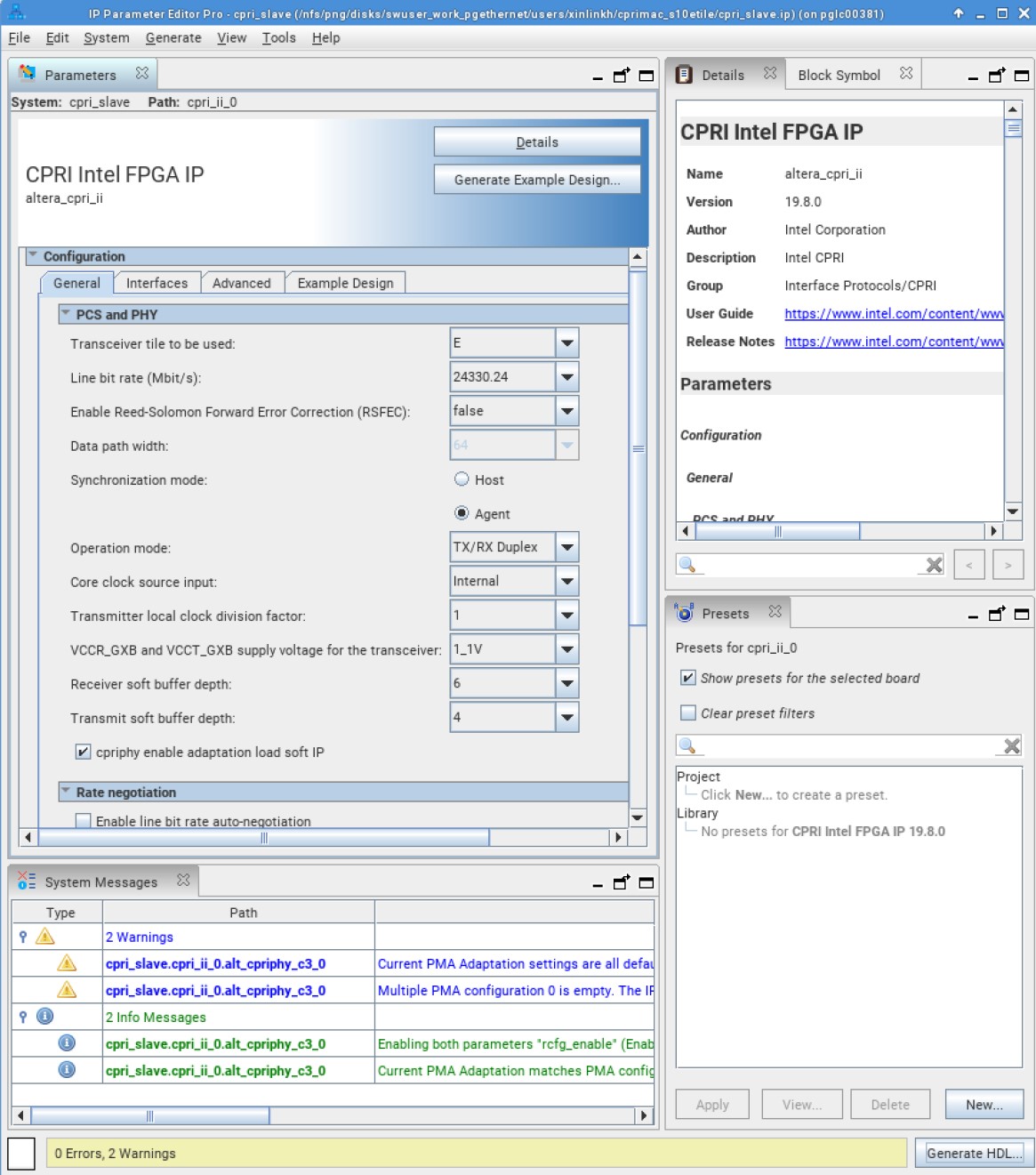Visible to Intel only — GUID: ewo1441317982922
Ixiasoft
2.1. Installation and Licensing
2.2. Generating aCPRI Intel® FPGA IP
2.3. CPRI Intel® FPGA IP Generated Files
2.4. CPRI Intel® FPGA IP Parameters
2.5. Integrating the CPRI IP into your Design: Required External Blocks
2.6. Simulating Intel FPGA IP Cores
2.7. Running the CPRI IP Design Example
2.8. CPRI Design Example Clocks
2.9. About the Testbench
2.10. Compiling the Full Design and Programming the FPGA
2.5.1. Adding the Transceiver TX PLL IP Core
2.5.2. Adding the Reset Controller
2.5.3. Adding the Transceiver Reconfiguration Controller
2.5.4. Adding the Off-Chip Clean-Up PLL
2.5.5. Adding and Connecting the Single-Trip Delay Calibration Blocks
2.5.6. CPRI IP Transceiver PLL Calibration
2.5.7. Reference and System PLL Clock for your IP Design
3.1. Interfaces Overview
3.2. CPRI Intel® FPGA IP Clocking Structure
3.3. CPRI Intel® FPGA IP Core Reset Requirements
3.4. Start-Up Sequence Following Reset
3.5. AUX Interface
3.6. Direct IQ Interface
3.7. Ctrl_AxC Interface
3.8. Direct Vendor Specific Access Interface
3.9. Real-Time Vendor Specific Interface
3.10. Direct HDLC Serial Interface
3.11. Direct L1 Control and Status Interface
3.12. L1 Debug Interface
3.13. Media Independent Interface (MII) to External Ethernet Block
3.14. Gigabit Media Independent Interface (GMII) to External Ethernet Block
3.15. CPU Interface to CPRI Intel® FPGA IP Registers
3.16. Auto-Rate Negotiation
3.17. Extended Delay Measurement
3.18. Deterministic Latency and Delay Measurement and Calibration
3.19. CPRI Intel® FPGA IP Transceiver and Transceiver Management Interfaces
3.20. Testing Features
3.19.1. CPRI Link
3.19.2. Main Transceiver Clock and Reset Signals
3.19.3. Arria V, Arria V GZ, Cyclone V, and Stratix V Transceiver Reconfiguration Interface
3.19.4. Arria® 10, Stratix® 10, and Agilex® 7 Transceiver Reconfiguration Interface
3.19.5. RS-FEC Interface
3.19.6. Interface to the External Reset Controller
3.19.7. Interface to the External PLL
3.19.8. Transceiver Debug Interface
Visible to Intel only — GUID: ewo1441317982922
Ixiasoft
2.2. Generating aCPRI Intel® FPGA IP
You specify CPRI IP options and parameters in the parameter editor to generate a custom Intel® FPGA IP variation
Figure 4. IP Parameter Editor


- In the Quartus® Prime Pro Edition software, click File > New Project Wizard to create a new Quartus® Prime project, or File > Open Project to open an existing Quartus® Prime project. The wizard prompts you to specify a device. In the Quartus® Prime Standard Edition software, this step is not required.
- In the Intel® FPGA IP Catalog (Tools > IP Catalog), locate and double-click the name CPRI Intel FPGA IP. The parameter editor appears.
- Specify a top-level name for your custom Intel® FPGA IP variation. The parameter editor saves the IP variation settings in a file named <your_ip> .ip (in Quartus® Prime Pro Edition) or <your_ip>.qsys (in Quartus® Prime Standard Edition). Click OK.
- Specify the parameters and options for your IP variation in the parameter editor, including one or more of the following. Refer to CPRI Intel FPGA IP Core Parameters for information about specific IP parameters.
- Specify parameters defining the IP core functionality, port configurations, and device-specific features.
- Specify options for processing the IP core files in other EDA tools.
- Click Generate HDL. The Generation dialog box appears.
- Specify output file generation options, and then click Generate. The IP variation files generate according to your specifications.
- To generate a simulation testbench: click Generate Example Design.
- For simulation, refer to the instructions in the Running the Testbench section.
- For synthesis, for Agilex™ 7 F-Tile, select device AGIB027R31B1E2V when generating hardware design example with Intel Agilex 7 FPGA I-Series Transceiver-SoC Development Kit.
Note: To generate a design example with line bit rate auto-negotiation option (Enable line bit rate auto-negotiation), you must also select the option Enable Auto Rate Negotiation ED. - To generate an HDL instantiation template that you can copy and paste into your text editor, click Generate > Show Instantiation Template.
- Click Finish. The parameter editor adds the top-level .qsys or .ip file to the current project automatically. If you are prompted to manually add the .qsys file to the project, click Project > Add/Remove Files in Project to add the file.
For Agilex® 7 F-tile devices:
- Copy the cpri_ii_tile_ip_gen.tcl from <your_ip>/altera_cpri_ii_c2p_top_<c2p version>/sim/ or <your_ip>/altera_cpri_ii_c2p_top_<c2p_version>/synth/ into the same level as <your_ip>.ip
- Execute this file using:
quartus_sh -t cpri_ii_tile_ip_gen.tcl <your_ip> skip_qtlg
- After generating and instantiating your IP variation, make appropriate pin assignments to connect ports.